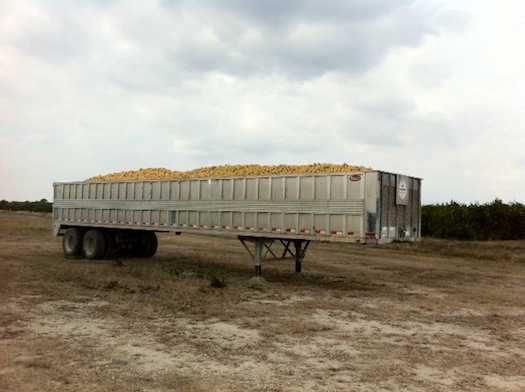
February 20, 2013
Orange City

The Dresden Zwinger
Because I’ve been on holiday in Florida, and because I’ve been reading John McPhee’s book on the subject, and because I’ve just read an urgent story on their potential demise, I’ve been thinking a lot about oranges, and also eating them and drinking their sweet juice.
An abiding love for the orange runs long in my family. When I was a child, my grandfather had large sacks of them shipped up to New York from Florida, and he would squeeze them every morning with a giant hand juicer. He liked all fruit, the more exotic the better, but especially oranges, and he traced this fascination to his own early years in the crowded tenement world of New York. The fruits his own father brought home were tokens of a brighter, sweeter, healthier, cleaner and greener world that then existed only in his imagination.
That the orange could be an antidote to the travails and toxins of the city has been a theme in their history and propagation, and one not unconnected to the development of architecture. According to McPhee, Thomas Wolsey, the English cardinal and politico, walked around 16th-century London with his nose pressed into a hollowed out orange, the better to protect himself from the city’s foul odors. The association of the fruit with tropical paradise — in particular, the mythical garden of the Hesperides — has prompted any number of urban and suburban gardners to plant thier own oranges. This impulse gave us the orangerie, the greenhouse-conservatory devoted to the royal celebration of citrus and sybaritic life. Oranges die if temperatures drop below 28 degrees Fahrenheit, necessitating the typology.
Spectacular orangeries were constructed by royals across Europe, among the most dramatic being those at Versailles (for Louis XIV), Dresden (the Zwinger, built for Emperor Frederick Augustus), and Laeken, outside Brussels (for Leopold II, built with the grim proceeds of his Congo terror.) You can make a case that the orangerie-greenhouse structures begat the great Crystal Palace in London, which in turn begat the era of glass-and-steel modern architecture. Or you can just enjoy them for what they are.

Trailer with oranges in Florida, 2013.
Today, we have an entirely new kind of infrastructure devoted to the preservation of the orange, or more correctly, their juice. As Nicola Twilley reports, in Florida, and presumably California as well, the corporate purveyors of orange juice have erected massive tank farms, at which pasteurized and de-oxygenated “pure premium” juice is stored at a steady 32 degrees in orderly rows of million-gallon, epoxy-lined cans.
These tank farms represent an irony few want to think about — certainly, the juice companies don’t want you to think about it — that being that orange juice, even the “pure premium” kind, which would seem to represent a welcome dose of bright unadulterated nature into our urbanized lives, is in fact an industrial product. When forced to think about this, people get upset. Very upset. It is, I suspect, a good part of the reason why there was such a furor, a few years ago, when Tropicana briefly changed the design of its cartons, this despite the fact that the new packaging was, in my estimation, perfectly good. The old image of a straw driven directly into an orange spoke directly to what we all would like to believe, but isn’t true: that the juice from the box is an unadulterated version of the juice from the fruit itself.
For a while after it was first introduced, I liked the cartoned “pure premium” orange juice, and drank it every morning. But I now find it bland and lacking the intense sugary snap of a glass of fresh squeezed juice. Like my grandfather, I like to make my own juice: it’s the perfect activity for someone who likes to cook but isn’t a skilled chef. There’s a rote mechanical labor to the process, and it is rewarded with something that is delicious. Unlike a complex recipe, you can’t screw it up. Your result is only dependent on the quality of your oranges, which may vary from morning to morning. That inconsistency, and a desire to avoid labor, is what gave us first orange juice from concentrate, and now boxed “fresh squeezed” orange juice, which isn’t.
It does not speak particularly well of our culture that we prefer the safety of consistency and the laziness of the carton to the potential rewards of work by hand. We can see the effects of this thinking in all facets of our lives, in architecture and urban design in particular. I think, especially, of our awful urban highways (convenience!) and the banality of so much of our built world (cookie-cutter condo!). It’s not a good trend.
As an antidote, I recommend buying some oranges and squeezing them, and I would not wait around to do it. As Scientific American reports, the American orange is in grave danger, threatened by a plague that is devastating trees by the acre, and for which there is at present no cure. For this reason, your orange, in the future, may be green. And that is not something to envy.
Observed
View all
Observed
By Mark Lamster
Related Posts

Equity Observer
L’Oreal Thompson Payton|Essays
‘Misogynoir is a distraction’: Moya Bailey on why Kamala Harris (or any U.S. president) is not going to save us

Equity Observer
Ellen McGirt|Essays
I’m looking for a dad in finance

She the People
Aimee Allison|Audio
She the People with Aimee Allison, a new podcast from Design Observer

Equity Observer
Kevin Bethune|Essays
Oh My, AI
Related Posts

Equity Observer
L’Oreal Thompson Payton|Essays
‘Misogynoir is a distraction’: Moya Bailey on why Kamala Harris (or any U.S. president) is not going to save us

Equity Observer
Ellen McGirt|Essays
I’m looking for a dad in finance

She the People
Aimee Allison|Audio
She the People with Aimee Allison, a new podcast from Design Observer

Equity Observer
Kevin Bethune|Essays
